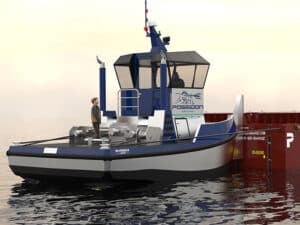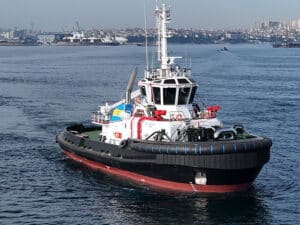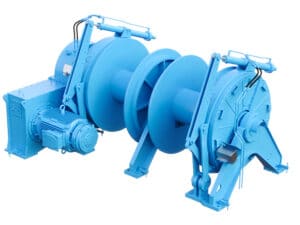
Damen sells first hybrid tug to Dutch owner
Written by Marine Log Staff OCTOBER 25, 2012—More and more consumers are considering buying hybrid cars because of the rising price of gas, environmental responsibility and increasing availability and lower cost of the technology at car dealerships.
OCTOBER 25, 2012—More and more consumers are considering buying hybrid cars because of the rising price of gas, environmental responsibility and increasing availability and lower cost of the technology at car dealerships.
With operators under increasing environmental regulatory pressure and fuel prices on the rise, Netherlands-based Damen Shipyards is trying to bring that same practical approach and lower cost technology to the marine market. “In the past, many green solutions were simply too expensive for the tugboat market,” says Erik van Schaik, Design & Proposal Engineer, Damen Tugs. “We were very mindful that this vessel had to cut fuel and emissions, but at the same time it had to be positioned at an attractive price for the market. We wanted to make being green commercially attractive too.”
While van Schaik notes that a hybrid tug costs about 10% more than a similar conventional tug, but the hybrid vessel operator will benefit from substantial fuel savings.
Depending on the operating profile of a tug, the ASD 2810 Hybrid, which has a combination of diesel-direct and diesel-electric propulsion, facilitates average fuel savings of between 10% and 30% and cuts local emissions by 20 to 60%. The vessel has a bollard pull of 60 tonnes.
Reducing greenhouse gas emissions, such as NOx, SOx and Particulate Matter, is becoming increasingly important as new Emissions Control Areas (ECAs) and tighter diesel engine regulations from IMO and the U.S. EPA, are implemented.
Damen started building hybrid tugs for stock and sold its first, the ASD 2810 Hybrid, to Dutch towing company Iskes Towage & Salvage, IJmuiden, the Netherlands, on Oct. 23 at Offshore Energy in Amsterdam. The pioneering Dutch shipyard group is believed to be the only yard worldwide building hybrid tugs for stock. The second hybrid vessel will be available from stock by the end of 2013.
Iskes Towage is no stranger to the ASD 2810 design tug. It has been operating a conventional ASD 2810 since November 2011. Iskes owner and Managing Director Jim Iskes says the next “logical move [was] to choose Damen for the Hybrid version.”
Iskes has been exploring its own green tug solutions, working with Offshore Ship Deigners on researching a hydrogen hybrid tug.
In early 2012, Damen and its partners, Smit internationale NV and Alewijnse Marine Technology, completed the three-year E3 project gathering data on the operational profile of a conventional ASD 2810 tug. During the monitoring campaign the E3 team found that the average load profile showed that tugs are running inefficiently for most of the time. For up to 80% of the day they can be free sailing, station keeping, running idle essentially, and in turn, this makes them less environmentally friendly and leads to higher operational costs.
The diesel-electric propulsion system in the ASD Tug 2810 Hybrid delivers enough power to prevent the main engines of the diesel direct propulsion system from running idle frequently or at low loads.
During the E3 project Damen’s Research Department made a computer simulation model to analyze various propulsion trains. Damen can use this simulation model to calculate the exact savings that are possible from the Hybrid in each individual case, based on the tug’s operating profile and running hours.
Based on the findings and after looking at various battery, LNG, hydrogen and compressed natural gas solutions, the Hybrid emerged. NOx, HC, CO, SOx, CO2 and particles all decrease substantially, as does fuel consumption.
As an option, Damen is also offering a battery pack that will make possible to shutdown all of the engines during station keeping, maneuvering and free sailing at low speeds, making the tug even more environmentally friendly. Battery packs of 100 kWh each are likely to be provided, which would allow the tug to sail up to 5 knots.
The Iskes Hybrid will incorporate batteries. Mr Iskes stressed that his company is very keen to have a combination of the diesel electric and batteries. “A 100kWh battery allows the vessel to be alongside the quay for eight hours and sail for an hour. And this represents a 10 to 15% fuel saving,” says Iskes.
“Batteries make it much more comfortable for the crew because when they are asleep, energy is coming from the batteries so there is no noise or emissions.”
Solar panels are added to the deckhouse on the Damen standard version and these are used to charge the 24V battery packs for starting the engines and emergency power for navigation lighting and radio equipment. Other green initiatives on the vessel include LED lighting, and a special paint coating, making the vessel more environmentally friendly and clean for at least five years.
Customization of the Iskes ASD Tug 2810 Hybrid for Anchor Handling includes double drum winches fore and aft, wooden decks and an open stern with towing pins and chain stopper forks.





Leave a Reply
You must be logged in to post a comment.